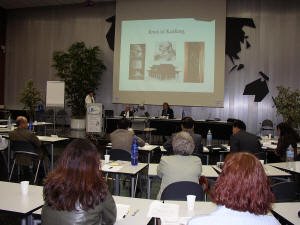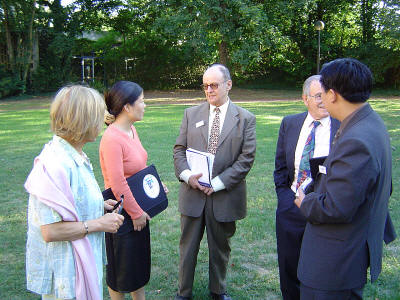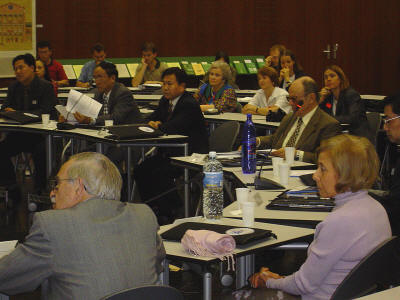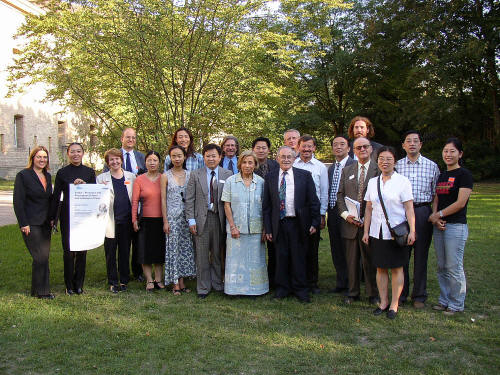|
Text in Deutsch
Short report on the international symposium with exhibition:
Youtai – Presence and Perception of Jews and Judaism in China
Within the framework of the same-named
research project in the School of Applied Linguistics and Cultural Studies
(FASK) of the Johannes Gutenberg University Mainz at Germersheim, September
19th to 23rd, 2003
The research project established by Prof. Dr. Peter
Kupfer (FASK, University of Mainz) and Prof. Dr. Roman Malek (Monumenta
Serica Institute, Philosophical Theological Faculty, Sankt Augustin) in the
years 2002-2003 in Germersheim is mainly focused on the Jewish community in
China.
This community had a synagogue, typical tradition and
religious practice in the old Chinese imperial city of Kaifeng, Henan
Province, which can be historically authenticated for the period spanning
the 12th (Northern Song Dynasty) to the 19th centuries. Due to a
centuries-old assimilation and acculturation process it gradually died out.
In recent years, however, in China and abroad more and more research is
being done about the history and culture of the Jews in China and in the
future too we can expect an increasing academic interest in all questions
connected with it. The project concentrates on the questions of the social
status and assimilation of Kaifeng Jews in Chinese society.
 An
international symposium based on more up to date sources and research
findings was held at the FASK at Germersheim, Germany, from 19th to 23rd
September, 2003. It focused on questions concerning the perception of
Judaism in Chinese society as well as among Chinese academics, the self
image of older and younger descendants in Kaifeng and their present status
in China and how China deals with the foreigner as part of its own history
and identity. The theme was systematically developed and discussed from
various historical, sociological, religious, ethnic, ethno-political and
intercultural points of view. Following the last conferences on this – in
1997 in Sankt Augustin ("From Kaifeng … to Shanghai. Jews in China," with
exhibition) and in 2002 in Nanjing ("History of Jewish Diaspora in China") –
emphasis was laid on the continuity of the research results and a broad
spectrum of various, new approaches with up to date references. Among the 14
speakers from Australia, China, Hongkong, Israel, Great Britain, France and
Germany who met for five days in Germersheim there were prominent
sino-judaists as well as younger hands in the field who presented their
latest findings in some excellent and informative papers. An
international symposium based on more up to date sources and research
findings was held at the FASK at Germersheim, Germany, from 19th to 23rd
September, 2003. It focused on questions concerning the perception of
Judaism in Chinese society as well as among Chinese academics, the self
image of older and younger descendants in Kaifeng and their present status
in China and how China deals with the foreigner as part of its own history
and identity. The theme was systematically developed and discussed from
various historical, sociological, religious, ethnic, ethno-political and
intercultural points of view. Following the last conferences on this – in
1997 in Sankt Augustin ("From Kaifeng … to Shanghai. Jews in China," with
exhibition) and in 2002 in Nanjing ("History of Jewish Diaspora in China") –
emphasis was laid on the continuity of the research results and a broad
spectrum of various, new approaches with up to date references. Among the 14
speakers from Australia, China, Hongkong, Israel, Great Britain, France and
Germany who met for five days in Germersheim there were prominent
sino-judaists as well as younger hands in the field who presented their
latest findings in some excellent and informative papers.

Three generations of researchers
The main auditorium of the FASK offered an ideal ambience
both for the symposium itself and the exhibition on Judaism in China at the
back of the hall. The exhibition was to continue until October 10th. Both
were open for interested parties at the University, Sinological and
Judaistic institutes, Jewish groups and the general public. Amongst other
things the official opening of the symposium included written words of
welcome by the President of Germany, Johannes Rau (who just a few days
before had visited the former Jewish ghetto in Shanghai), the chairman of
the Central Jewish Committee, Paul Spiegel, and of the Center for Jewish
Studies of the Academy of Social Sciences in Shanghai. The programme of
events began on September 19th with a greeting from the dean of FASK, Prof.
Dr. Wolfgang Pöckl, and some introductory remarks by Prof. Kupfer who
introduced the participants. He concluded by thanking the promoters of the
symposium and exhibition: the Center for Intercultural Studies at the
Johannes Gutenberg University, Mainz (ZIS), the German Research Foundation
(DFG), The Rhineland Palatine Ministry of Science, Further Education,
Research and Culture, as well as numerous sponsors and helpers.
Prof. Dr. Roman Malek (Monumenta Serica, Sankt Augustin)
began the symposium by delivering an introductory paper on the theme: "
'Marginal Religions' in Chinese History of Religion: The Case Study of
Judaism." He discussed the definition of Judaism as a "marginal religion,"
illustrating this by examining its historical background in comparison to
other religions and their adoption of Confucian orthodoxy. The following day
in his presentation entitled "Chinese Jews: Prospects for Research" with an
overview of the history and present stage of research on Judaism in China
Prof. Dr. Donald D. Leslie (Canberra) succeeded in pointing out research
deficiencies and ongoing questions, partly correcting them.
With the help of some informative illustrations Prof. Dr.
Pan Guang (Shanghai Academy of Social Sciences) in his paper "Jews in China:
Legends, History and New Perspectives," described the various Jewish
migrations and their settlements in China from the earliest times to the
present. In her presentation "From Judaism to Confucianism: Studies on the
Internal Causes for Assimilation of the Kaifeng Jewish Community," Prof. Dr.
Zhang Qianhong (Henan University, Kaifeng) examined the
heretofore-unrecognized internal reasons for assimilation based on complex
ideological processes of change.

Scene at the symposium: (first row from left to right)
Dr. Donald D. Leslie (Australia), Dr. Maisie Meyer (U.K.),
Prof. PAN Guang (China), Dr. Salomon Wald (France),
Prof. XU Xin (China), Prof. YIN Gang (China) and
Mr. Zhang Ligang (China)
A member of the new generation of academics, Zhang Ligang
(Henan University, Kaifeng), in his paper on "The Understanding and Attitude
of Chinese Society towards the Kaifeng Jews" focused on the perception and
relationship of the Chinese authorities and society towards the Kaifeng Jews
during the various epochs from the Song Dynasty up to the present day. Ms.
Wei Naxin (graduate in translation studies, Mainz University) presented a
report entitled "Contemporary Perception of Jews and Judaism among the
Jewish Descendants in Kaifeng," revealing the results of a survey by means
of questionnaires carried out in the spring of 2003 and interviews of the
descendants of Kaifeng Jews recorded in 2000 and 2003.
In his paper "Between Disintegration and Expansion – A
Comparative Retrospection of the Kaifeng Jewish and Muslim Community" Prof.
Yin Gang (Chinese Academy of Social Sciences, Beijing) presented a
historically comparative overview and heretofore lesser known facts about
the Moslem and Jewish communities in Kaifeng during the Song, Jin, Yuan, and
Ming Dynasties and examined the background of the gradual weakening of the
Jewish community on the one hand and the expansion and strengthening of the
Islamic community on the other.
In his paper "What's Holding back the Reconstruction of
the Kaifeng Synagogue? Between Revival and Obliteration of Kaifeng Jewry"
the young Israeli sinologist Noam Urbach (Hebrew University, Jerusalem)
sketched the results of his field work in Kaifeng and for the first time
explained the political background which after the beginning of China's
policy of openness first led to a flurry of activity on the part of the city
government and several personalities in Kaifeng for the revival of Jewish
culture in 1993 but then in 1996 to a sudden ending of all these
initiatives.
In a paper entitled "Baghdadis, 'Chinese Jews' and
Chinese" Dr. Maisie Meyer (London) described the life and circumstances of
the Bombay Sephardic business people who settled as British citizens in the
then opened trading port of Shanghai after the passing of the Treaty of
Nanjing in 1842. The efforts of these Sephardic Jews in the periods
1898-1904 and 1924-1932 to revive the Jewish culture in Kaifeng were in vain
but testified to their strong identity with the Jewish culture present in
Shanghai until 1949.
In his paper "A Comparison between Hillel and Confucius:
The Proscriptive versus the Prescriptive Formulation of the Central Ethical
Principle in the Jewish and Chinese Ethical Traditions" Prof. Robert E.
Allinson (Chinese University of Hongkong) asserted that in both the Jewish
and Chinese ethical tradition prescriptive as well as proscriptive
formulation are of importance, as this is expressed in the "Golden Rule." He
arrived at the conclusion that in both traditions a similar semantic
framework is supposed and common ethical values are defined.
In his scholarly contribution entitled "Chinese Jews in
European Thought" Dr. Salomon Wald (The Jewish People Policy Planning
Institute, Jerusalem/Paris) analyzed the reactions of European thinkers such
as Menasseh Ben Israel, Leibniz, Voltaire, Basnage, Marquis d'Argens, Kant
and Abbé Grégoire to the discovery of the Jewish community in Kaifeng. In a
contribution "The 'Jews' in the May Fourth Period" Dr. Zhou Xun (SOAS,
University of London) lectured on the modern Chinese "image of the Jew"
during the May Fourth Movement or New Cultural Movement between 1915 and the
1930's.
Having glanced retrospectively at the 1000-year history of
"Chinese Judaism" in his paper on "Chinese Policy towards Judaism" Prof. Dr.
Xu Xin (Nanjing University) revealed many heretofore-unknown details
concerning Chinese policy since 1950 concerning the treatment of descendants
of the Kaifeng Jews. In the concluding paper of the symposium "The Situation
of Jewish Culture in China in the Past, Present and Future" Prof. Dr. Peter
Kupfer (University of Mainz, Germersheim) examined the situation of the
Kaifeng Jews and their descendants with respect to the conservation of the
Jewish heritage. The symposium ended in the late afternoon of September 22nd
with a lively discussion. The general conclusion was that the symposium
constituted a new milestone in Sino-Judaistic research.
Last but not least has to be mentioned the interesting and
lavishly prepared supporting programme for the symposium which included a
conducted tour through the walled city of Germersheim and through the FASK
itself which incorporates the biggest and most modern interpreting
institutes in the world. Other items on the programme included an evening
concert of medieval music entitled "In the Steps of Abraham" in Speyer
cathedral, a reception in the FASK institute on the occasion of the opening
of the exhibition on Judaism in China (with about 60 invited guests) and a
German-Hebrew Erzählkonzert performed by the accordianist, Revital Herzog.
Other items included excursions to Speyer (conducted tour of the cathedral
by Bishop Dr. Anton Schlembach, visit to the Jewish Bath), Worms (synagogue,
Raschi House, and Jewish cemetery), and to the Osthofen concentration camp
memorial. The programme concluded with a trip through the scenic German
Weinstraße.

Participants and supporters of the symposium
Text in Deutsch
hagalil.com
02-12-2003 |